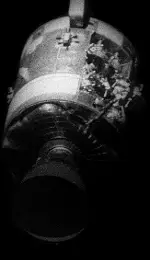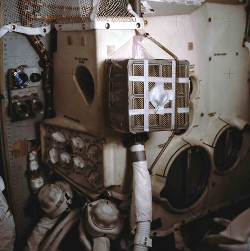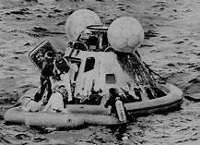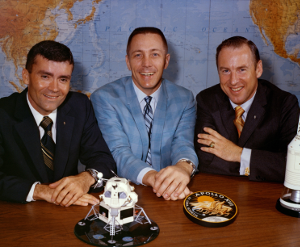Apollo 13: Escaping Death in Space
Apollo 13 was supposed to be the third mission to land people on the Moon; instead, it was a triumph of ingenuity over adversity, of determination over nearly impossible odds. The first two Moon landing missions, Apollo 11 and Apollo 12, had succeeded in doing the seemingly impossible: landing humans on another world 252,000 thousand miles away and getting them safely home again, through hostile space and an even more hostile Earth's atmosphere. The crews of those two missions had completed all of their tasks to precision, and Apollo 12 had improved on the Apollo 11 launch location. Commanding the Apollo 13 mission was James Lovell (left, right), who had logged more time in space than anyone else, having flown on Gemini 7 and Gemini 12 and as commander of Apollo 8, the first American The one change to the crew as originally appointed was that Ken Mattingly, who was to have served as Command Module Pilot, had been grounded because he had no immunity to rubella, German measles. Charlie Duke, the backup Lunar Module Pilot, got the disease from one of his children and inadvertently shared it with not only the rest of the backup crew but also with all of the primary crew. Of all six, only Mattingly had not had rubella as a child. Replacing Mattingly was Jack Swigert (left, center), who had been part of the support crew for Apollo 7. (Mattingly never did develop the disease and did finally get his trip into space, aboard Apollo 16.) Launch date for Apollo 13 was April 11, 1970. The launch proceeded without incident and, after a series of burns and maneuvers, the crew were on their way to the Moon. Two days in, on April 13, the crew had just finished a TV broadcast that explained what it was like in the spacecraft and what their mission would entail when they got to the lunar surface when NASA controllers noticed a warning signal on a hydrogen tank in the orbiting craft, which was named Odyssey. Warning signals and lights were not uncommon on Apollo mission; some had been problems that had been overcome, and others had been false alarms. After a discussion between crew and Mission Control, the astronauts proceeded with what they thought would be a routine procedure. Swigert flipped a switch in order to turn on the hydrogen and oxygen tank stirring fans, and moments later the crew felt a large jolt. What happened was a series of bad news: warning lights lit up across the board, on the spacecraft and back at Mission Control, showing a drop in power and oxygen pressure. 
Swigert was the one who radioed the news to NASA, saying, "Houston, we've had a problem here." The problems were many. One of the most critical was that the sharp jolt that the crew had felt was actually an explosion that had blown a large hole in one oxygen tank and slightly damaged another. The spacecraft ran on oxygen, which was why the power had been cut. The spacecraft was venting oxygen, and they didn't exactly have a huge backup supply. They would need it not only to power their machines but also to breathe. The spacecraft that was damaged was Odyssey, the Service Module. After scrapping the journey to the Moon, the crew set about trying to get home again. They were 205,000 miles away. One of the first decisions that they made was to turn Aquarius, the Lunar Module, into a "lifeboat," a substitute living quarters for the return flight (a scenario that had been suggested during a training scenario but deemed unlikely). It would be cramped quarters, since the little craft was built to house two astronauts for only a couple of days, but Haise and Lovell quickly went to work getting it ready to receive all three of the crew. Swigert stayed behind in Odyssey, shutting down everything in sight in order conserve power for the last stage of the journey, then joined the other two in cramped Aquarius. Because of the lack of fuel and power, NASA decided to use the Moon's gravity as a slingshot to send the spacecraft back home, so they actually had to go around the Moon in order to get back to Earth. The return journey would take four days. A further complication was that Aquarius didn't have a heat shield to protect the crew during re-entry into the Earth's atmosphere; so, the crew would have to squeeze into Aquarius, survive near-freezing temperatures for a few days, and then climb back into Odyssey for the final descent. Once inside Aquarius, the crew shut down every system that wasn't vital. The cabin temperature dropped precipitously. The crew rationed water as well because that would be needed to cool the bits of machinery that were still working. Because of the harsh conditions, the astronauts slept little and NASA was worried that they would be too fatigued to perform the tasks necessary for re-entry. 
The crew were also causing another problem simply by breathing. Even though they had limited their oxygen supply, they could do nothing about the carbon dioxide that they were venting into the spacecraft cabin just by exhaling. Aquarius had a system to cleanse the air, but it was designed to accommodate two people for two days, not three people for four days. Compounding the problem was the fact that they couldn't "strap on" a system from Odyssey because the two filters were not interchangeable. In one of the space program's more legendary but true examples of genius, scientists on the ground figured out a way for the crew up in space to use the hardware and tools that they had onboard–such as maps and duct tape–to create a workaround; it worked. One of the Mission Control crew working tirelessly to find solutions based on ground-based simulations was Mattingly. The trip home was difficult from a flying point of view because the explosion had knocked the spacecraft off course and the crew was going to have make two course corrections, each of which would eat into the already low supplies of both oxygen and power. As well, the second course correction would have to make use of calculations that the crew would have to do themselves. Calling on experience gained by Lovell and his crew during the Apollo 8 mission, the astronauts figured out a way to get it all done. Another possible difficulty was that the Command Module had been shut down completely in order to conserve power and the crew would have to start it from a very cold temperature en route. Thermometers inside the craft had reported temperatures as low as 39° Fahrenheit, which created condensation that could interfere with electrical systems powering back up. This had never been attempted because the spacecraft wasn't designed to do such a thing, but NASA scientists on the ground wrote out protocols for doing it anyway, completing a three-month task in three days. In the end, this part of the journey proved to be not a difficulty at all, and the crew, once back inside Odyssey, powered back up and waited for the final descent. 
The crew jettisoned the service module four-and-one-half hours before re-entry, and they got a look at the damage: it was severe. They climbed back into the Command Module, jettisoned the Lunar Module not long afterward, and made it back through the atmosphere to a safe splashdown in the Pacific, on April 17. The exhaustive investigation that followed found that causing the explosion was a combination of high temperatures melting insulation on supply wires, leaving them exposed, and a subsequent electrical spark that boiled liquid oxygen faster than the tank could vent it. Scientists built a replica oxygen tank down to the last detail, simulated the conditions, and observed a similar explosion, thus proving their theory. As with every mission, NASA learned from the set of events that comprised the Apollo 13 mission. Improvements made to the spacecraft before the next mission were extensive. |
|
Social Studies for Kids
copyright 2002–2025
David White



 manned mission to orbit the Moon. Also in the crew was Lunar Module Pilot
manned mission to orbit the Moon. Also in the crew was Lunar Module Pilot 
